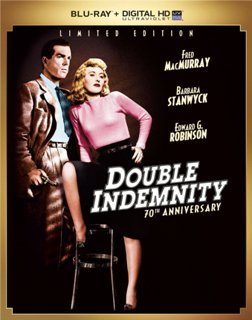- Joined
- May 9, 2003
- Messages
- 3,103
Double Indemnity insures its claim on Blu-ray with a 70th Anniversary Edition that provides a lovely HD picture and all the bonus features from the 2006 Legacy Edition DVD. The film is a film noir classic, one of the first of its kind and still one of the best, featuring extraordinary performances by Fred MacMurray, Barbara Stanwyck and Edward G. Robinson, a crackling script by Billy Wilder and Raymond Chandler, and beautifully understated direction by Wilder This is another thorough study of a classic film on disc, complete with a pair of detailed commentaries, a robust featurette about the movie and even the inferior 1973 TV movie for comparison purposes. This release is Highly Recommended.

Studio: Universal
Distributed By: N/A
Video Resolution and Encode: 1080P/AVC
Aspect Ratio: 1.33:1
Audio: English 2.0 DTS-HDMA, Other
Subtitles: English SDH, Spanish, French
Rating: Not Rated
Run Time: 1 Hr. 48 Min.
Package Includes: Blu-ray, Digital Copy, UltraViolet
Disc Type: BD50 (dual layer)
Region: ABC
Release Date: 04/15/2014
MSRP: $29.98
The Production Rating: 5/5
Video Rating: 5/5 3D Rating: NA
Audio Rating: 5/5
Special Features Rating: 5/5
Overall Rating: 5/5
Reviewed By: Kevin EK
Support HTF when you buy this title:





